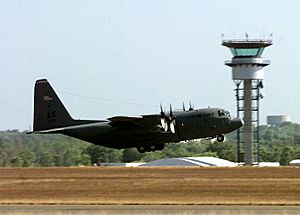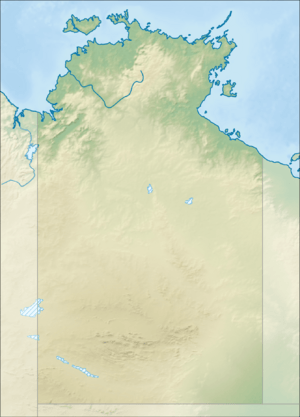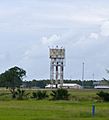RAAF Base Darwin facts for kids
Quick facts for kids RAAF Base Darwin |
|||||||||
|---|---|---|---|---|---|---|---|---|---|
| Darwin, Northern Territory in Australia | |||||||||

A USAF C-130 taking off from RAAF Base Darwin in 1999
|
|||||||||
|
Location in the Northern Territory
|
|||||||||
| Coordinates | 12°24′53″S 130°52′36″E / 12.41472°S 130.87667°E | ||||||||
| Type | Military airfield | ||||||||
| Site information | |||||||||
| Owner | Department of Defence | ||||||||
| Operator | |||||||||
| Site history | |||||||||
| In use | 1 June 1940 – present | ||||||||
| Battles/wars | Bombing of Darwin, World War II | ||||||||
| Garrison information | |||||||||
| Occupants |
|
||||||||
| Airfield information | |||||||||
| Identifiers | IATA: DRW, ICAO: YPDN | ||||||||
| Elevation | 31 metres (103 ft) AMSL | ||||||||
|
|||||||||
RAAF Base Darwin is a military air base for the Royal Australian Air Force (RAAF). It is located in Darwin, Australia. This base shares its runway with Darwin International Airport, which is used for regular flights. RAAF Base Darwin is a special "forward operating base" that is always busy. About 400 people work there all year round.
Contents
History of RAAF Base Darwin
The building of the airfield started in 1938. RAAF Station Darwin officially opened on 1 June 1940. Two RAAF squadrons, No. 12 Squadron and No. 13 Squadron, were based there from the start.
World War II and Darwin
During World War II, many RAAF and United States Army Air Forces (USAAF) units used the base. Japanese forces bombed the base many times. The first big attacks happened on 19 February 1942, during the Bombing of Darwin.
RAAF Base Darwin was a safe place for USAAF units retreating from the Philippines in 1941. American air force groups, like the 49th Fighter Group, were based there before moving to other locations in 1943. From 1944 to 1945, the USAAF 380th Bombardment Group used the base. They flew long-range B-24 Liberator bombers from Darwin.
This group received a special award for their attacks on oil refineries and shipping in Borneo. They also bombed enemy airfields in New Guinea to help American landings.
Important Buildings and History
Some parts of the base, covering about 45 hectares (111 acres), are listed as important heritage sites since 2004. This means they have historical value. The base is important because it shows how Australia prepared its defenses before World War II. It was a big step for Australia to build such a large military base in the north.
Many old buildings on the base are part of this heritage list. These include timber-framed houses, the Sergeants Mess, the Single Officer's Mess, and the Administrative Building. Other important structures are the Gymnasium, Canteen, the Commanding Officers' Residence, a chapel, a water tower, and the Guard House.
Units at RAAF Darwin During WWII
- No. 12 Squadron RAAF
- No. 13 Squadron RAAF
- No. 34 Squadron RAAF
Modern Day Operations
In 1975, after Cyclone Tracy hit Darwin, the base became a central point for a huge airlift. Most of Darwin's people were flown out of the city from this base.
RAAF Base Darwin has a very long runway, which made it an emergency landing site for the NASA Space Shuttle. Large American military planes, like B-1 Lancer and B-52 Stratofortress bombers, can also use the base. Tanker planes, such as the KC-10 and KC-135, also operate from RAAF Base Darwin.
In 2010, there were plans to add extra soundproofing to houses near the base. This was to help with the loud noise from new Joint Strike Fighter jets.
Current Units at RAAF Base Darwin
RAAF Base Darwin is home to several important RAAF units today. These units help with surveillance, combat support, and air operations.
| Unit name | Force Element Group | Aircraft/equipment |
|---|---|---|
| Headquarters No. 452 Squadron | Surveillance and Response Group | |
| No. 452 Squadron Darwin Flight | Surveillance and Response Group | |
| No. 92 Wing Detachment B | Surveillance and Response Group | AP-3C Orion |
| No. 114 Mobile Control and Reporting Unit | Surveillance and Response Group | AN/FPS-117 radar |
| Headquarters No. 396 Combat Support Wing | Combat Support Group | |
| No. 321 Expeditionary Combat Support Squadron | Combat Support Group | |
| No. 1 Air Terminal Squadron Detachment Darwin | Combat Support Group | |
| No 13 (City of Darwin) Squadron | Combat Support Group (RAAF Active Reserve) |
Gallery




